
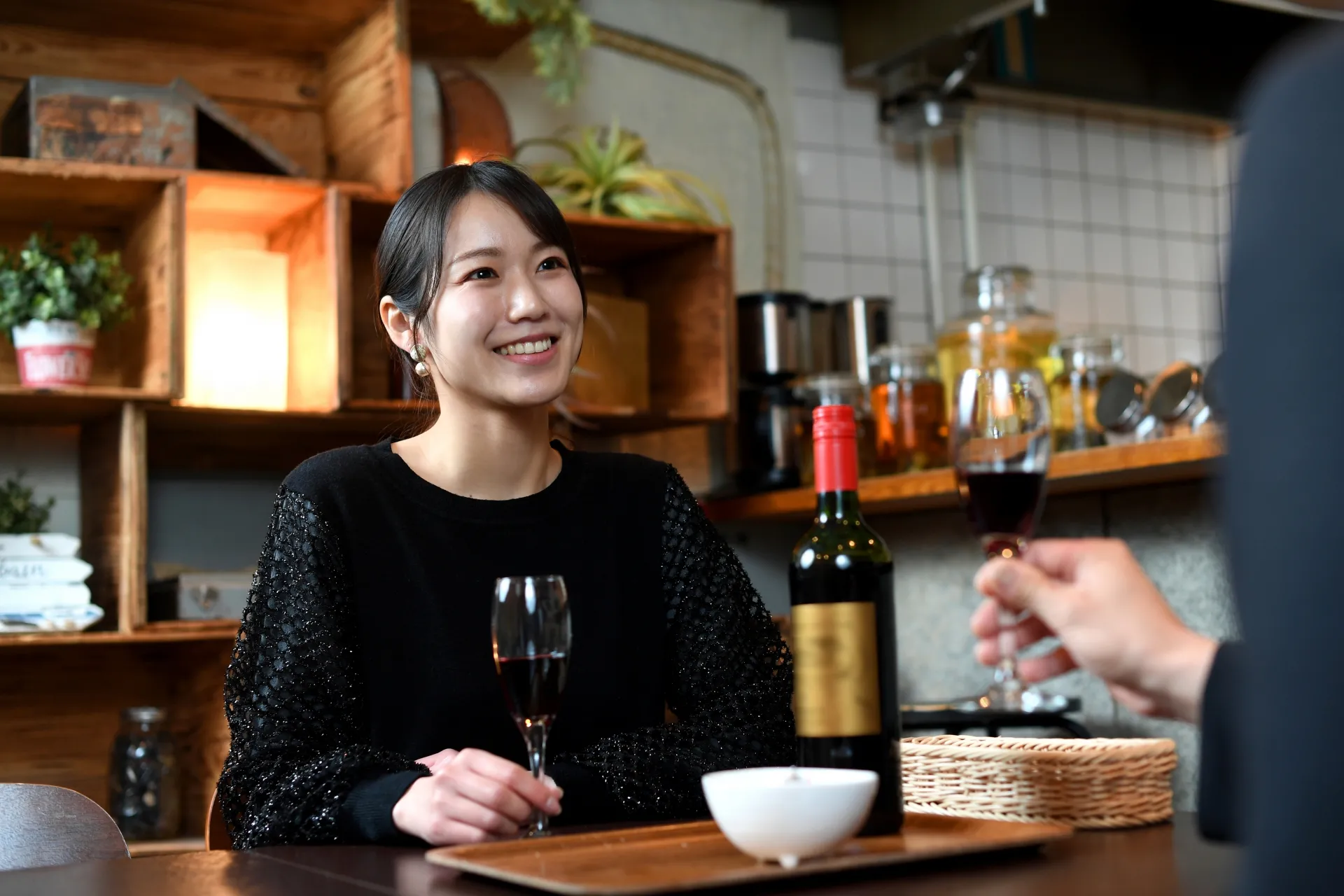
Have Fun Speaking Japanese! Useful Phrases for Restaurants
Do you enjoy Japanese food? Trying new dishes is one of the most enjoyable experiences. Eating out is called “外食:Gaishoku” in Japanese.
Types of Restaurants in Japan
Here are some types of restaurants in Japan:
レストラン (Resutoran) – Restaurant
食堂 (Shokudō) – Cafeteria / Casual dining hall
カフェ・喫茶店 (Kafe / Kissaten) – Café / Coffee shop
ラーメン屋 (Rāmen-ya) – Ramen shop
回転寿司 (Kaiten-zushi) – Conveyor belt sushi restaurant
ファストフード (Fasuto fūdo) – Fast food restaurant
居酒屋 (Izakaya) – Japanese-style pub
ファミレス (Famiresu) – Family restaurant
The way to order food differs depending on the type of restaurant; however, it’s not as intricate as you might expect. Let’s explore some useful phrases you can use when communicating with staff.
Entering the Restaurant
When entering the restaurant, the first thing you typically tell the staff is how many people are in your group. In Japanese, you can say:
Staff: “いらっしゃいませ。何人/何名ですか。(Irasshaimase. Nannin / nenmei desuka?)”
※ 何人 (Nannin) / 何名 (Nanmei) – Both mean “How many people?”
Customer: “3人です。(Sannin desu.)” – “We are three people.”
※ 客 (Kyaku) / お客様 (Okyaku-sama) – Refers to “customer” or “guest.”
When telling the number of people:
1人 (hitori) – 1 person
2人 (futari) – 2 people
3人 (sannin) – 3 people
4人 (yonin) – 4 people
5人 (gonin) – 5 people
6人 (rokunin) – 6 people
When you have a reservation, you can say:
Customer: “予約をしています。(yoyaku wo shiteimasu)” – “I have a reservation.”
※ 予約 (yoyaku) – Reservation
The staff will guide you to your seat.
Staff: “こちらの席にどうぞ。 (kochira no seki e douzo)” – “Please take this seat.”
※ 席 (seki) – Seat
Staff: “空いている席へどうぞ。 (Aiteiru seki e douzo)” – “Please take an available seat.”
Staff: “お好きな席にどうぞ。 (Osuki na seki ni douzo)” – “Please take whichever seat you prefer.”
Staff: “カウンターとテーブルとどちらがいいですか。 (Kaunta- to te-buru to dochira ga ii desuka)” – “Would you prefer a counter or a table?”

Counter
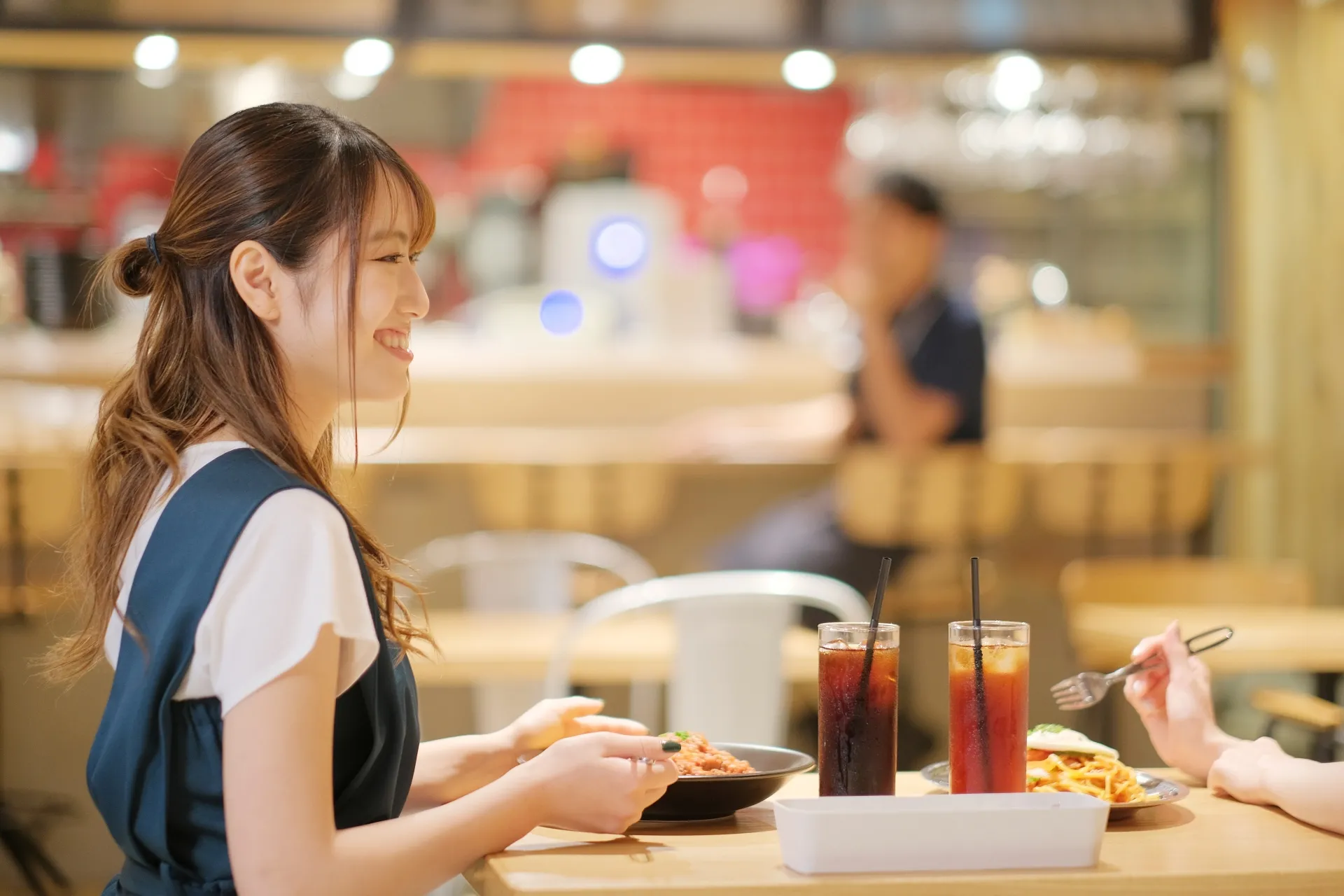
Table
If you have a particular preference, you can say:
Customer: “テーブルでおねがいします。(Te-buru de onegai shimasu)” – “I would like a table, please.”
Customer: “あそこでもいいですか。(Asoko demo iidesuka)” –“Is it okay to take that seat over there?”
Customer: “あの席がいいです。(Ano seki ga iidesu)” – “I would like that seat.”
When taking a seat, you will typically be provided with a menu, water, and a wet towel. Please be assured that water and wet towels are generally provided free of charge.
When you don’t understand the Japanese menu, you can ask:
Customer: “英語のメニューはありますか?(Eigo no menyu wa arimasuka?)” – “Do you have an English menu?”
Ordering Food
Here are some phrases you can use when ordering:
Staff: “ご注文はお決まりですか。(Gochumon wa okimaridesuka)” – “Have you decided on your order?”
Customer: “〇〇をお願いします。(〇〇 wo onegaisimasu)” – “I’ll have 〇〇, please.”
Customer: “〇〇にします。(〇〇 ni shimasu)” – “I’ll go with 〇〇.”
Customer: “これとこれをお願いします。(kore to kore wo onegaishimasu)” – “I’ll have these two, please.”
Customer: “これにします。(kore ni shimasu)” – “I’ll have this one.”
(While pointing at the menu)
“お願いします (onegaishimasu)” can be used in many situations where you need something, like:
水 (mizu) – water
お茶 (ocha) – tea
スプーン (supūn) – spoon
取り皿 (torizara) – small plate
Customer: “水、お願いします。(Mizu onegai shimasu)” – “A cup of water, please.”
When the staff comes to take your order, but you still haven’t decided yet, you can say:
Customer: “すみません、まだです。(Sumimasen madadesu)” – “Sorry, I’m not ready yet.”
Customer: “ちょっと待ってください。(Chotto Matte kudasai)” – “Please give us a second.”
The staff will most likely tell you to call them when you are ready to order:
Staff: “お決まりになりましたらお呼びください。(Okimari ni narimashitara oyobi kudasai)” – “Please let us know when you are ready.”
Staff: “お決まりになりましたら、ボタンを押してください。(Okimari ni narimasitara botan wo oshite kudasai)” – “When you’re ready to order, please press the button.”
When you want the staff to come, you can call them by saying:
Customer: “すみません。(Sumimasen)” – “Excuse me.”
Customer: “おねがいします。(Onegaishimasu)” – “Please”
You may encounter self-service ordering systems, such as ticket vending machines or touch screens at ramen shops or conveyor belt sushi restaurants, where you place your order independently, instead of calling the staff.
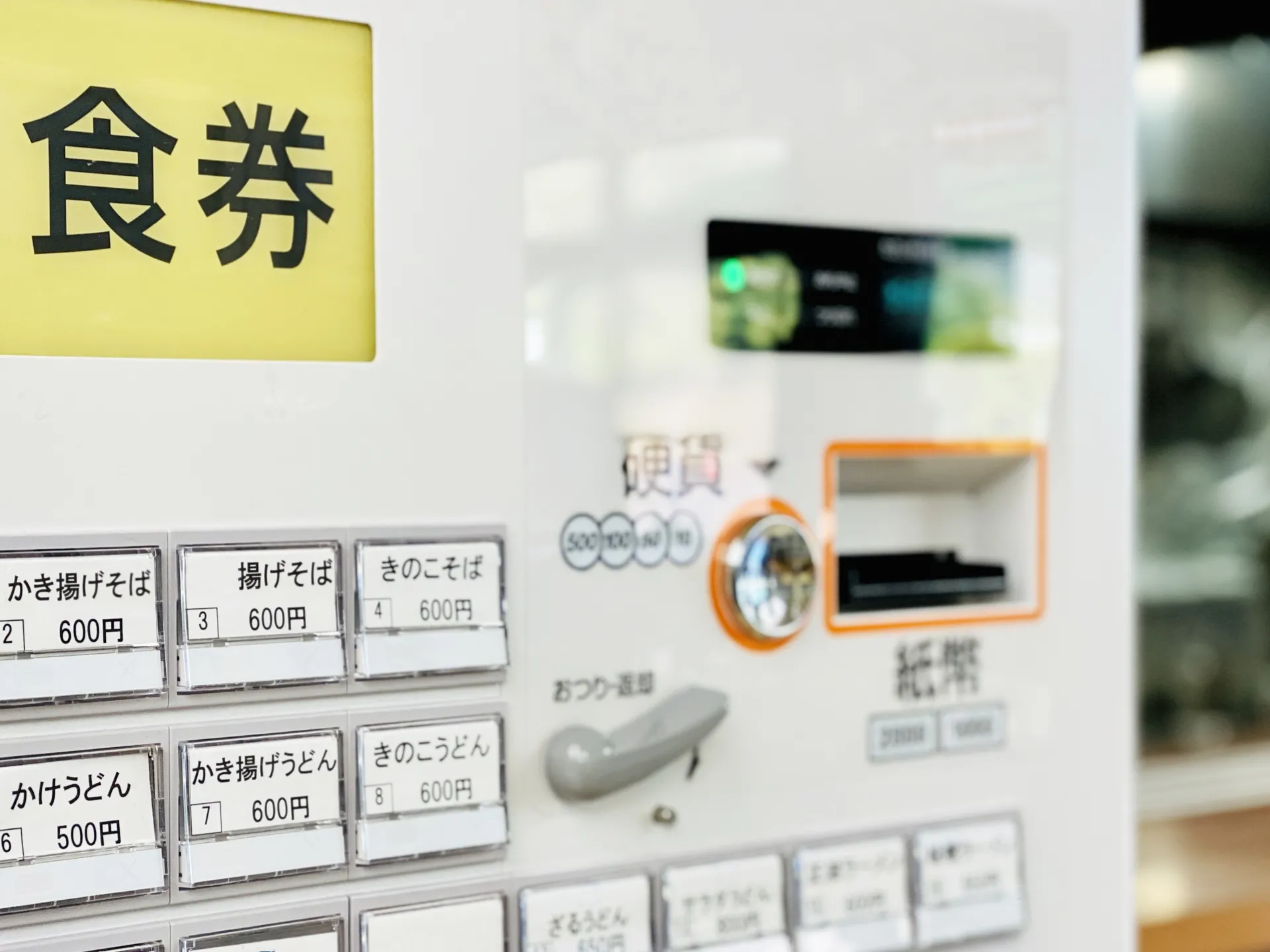
※ 食券 (shokken) – “Ticket machine”
You purchase a ticket to place your order at the vending machine by inserting coins and pressing the button. Then, hand the ticket to the staff.
※ タッチパネル (tacchi paneru) – “Touch screen”
You place your order using tablets provided at each seat. These screens typically display pictures of the menu, and you can change the language.
If you are unsure how to use them, you can politely ask:
Customer: “すみません。わかりません。(sumimasen wakarimasen)” – “Excuse me, I’m not sure how to use this.”
Paying the Bill
先払い (Sakibarai) – Prepayment
The style where payment is made in advance when placing the order is commonly seen in fast food restaurants and ramen shops.
後払い (Atobarai) – Postpayment
After eating, you pay when you leave the restaurant. When you’re ready to pay, you can say:
Customer: “お勘定お願いします。 (Okanjo onegai shimasu)” – “Could I have the bill, please?”
Customer: “お会計お願いします。 (Okaikei onegai shimasu)” – “Could I have the check, please?”
※ お勘定 (Okanjo) / 会計 (Kaikei) refers to paying the bill or check in restaurants or similar establishments.
Methods of Payment
Staff: “お支払いはどうなさいますか。(Oshiharai wa dou nasaimasuka)” – “How would you like to pay?”
Customer: “現金で。(Genkin de)” – “By cash.”
Customer: “カードで。(Ka-do de)” – “By card.”
Customer: “QRで。(Kyu-a-ru de)” – “By QR code. ”
Customer: “電子マネーで。(Denshi mane- de)” – “By mobile payment.”
Some small businesses or restaurants may only accept cash, especially during certain hours like lunchtime when they offer discounts. It’s always good to have some cash on hand in case of these situations.
Staff: “お支払いはご一緒でよろしいですか。(Oshiharaiwa goissho de yoroshii desuka)” – “Would you like to pay together?”
Customer: “いっしょで。(Issho de)” – “Together, please”
Customer: “べつべつで。(Betsubetsu de)” – “Separate, please”
When you want a receipt:
Customer: “領収書お願いします。(Ryoshusho onegai shimasu)” – “Could I have a receipt, please.”
Ask the Staff
Here are some phrases you can use when you would like to place an order or ask for information:
Customer: “おすすめはなんですか。(Osusume wa nandesuka)” – “What do you recommend?”
Customer: “ベジタリアンメニュ-はありますか。(Begitarian menyu wa arimasuka)” – “Do you have a vegetarian menu?”
Customer: “ハラルメニューはありますか。(Hararu menyu wa arimasu ka)” – “Do you have a halal menu?”
When you want to inquire about the ingredients used in dishes or have something specific you cannot eat, you can ask:
Customer: “〇〇は入っていますか。(〇〇 wa haitte imasuka)” – “Does it come with 〇〇 in this?”
Customer: “〇〇が入っていない料理はどれですか。(〇〇ga haitteinai ryori wa doredesuka)” – “Which dishes do not contain 〇〇?”
Customer: “〇〇が食べられません。(〇〇 ga taberaremasen)” – “I cannot eat 〇〇.”
When there are ingredients you dislike or cannot eat, for example, if you want sushi but cannot eat wasabi, you can say:
Customer: “わさびぬきでお願いします。(Wasabi nuki de onegaishi masu)” – “No wasabi, please.”
“〇〇 nuki” means “without 〇〇.” You can use this phrase when you want to exclude ingredients like mustard, green onions, cilantro, mayonnaise, etc.
Sometimes you will be asked about the level of spiciness at a ramen shop or curry shop. Here are some phrases you may encounter:
Staff: “辛さはどうしますか。(Karasa wa doushimasuka)” – “How spicy would you like it?”
Customer: “一番辛くしてください。(Ichiban karaku shite kudasai)” – “Please make it the spiciest.”
Customer: “ふつうで。(Futsuu de)” –“Regular level, please.”
Customer: “辛くしないでください。(Karaku shinaide kudasai)” – “Please don’t make it spicy.”
Some restaurants will ask you about the portion size of food or white rice that comes with the meal. Here are the phrases:
Staff: “ご飯の量はどうしますか。(Gohan no ryou wa doushimasuka)” – “How would you like the portion of rice?”
Customer: “大盛で。(Omori de)” – “Large, please.”
Customer: “ふつうで。(Futsu de)” – “Regular, please.”
Customer: “少なめで。(Sukuname de)” – “Small, please.”
Let’s Have More Interactions with the Staff
If you are satisfied with the quality of the food and would like to compliment them on how delicious it was, or simply when you want to engage in communication, you can say:
Here are some basic greetings:
Before eating:
“いただきます。(Itadakimasu)” – “Thank you for the meal.” / “Let’s eat.”
After eating:
“ごちそうさま。(Gochiso sama)” – “Thank you for the meal.
When receiving a service:
“ありがとうございます。(Arigato gozaimasu)” – “Thank you.”
Let’s ask the staff:
“この料理の名前はなんですか。(Kono ryori no namae wa nandesuka)”
– “What is the name of this dish?”
“作り方を教えてください。(Tsukurikata wo oshiete kudasai)”
– “Could you please tell me how this is made?”
“写真を撮ってもいいですか。(Shashin wo tottemo iidesuka)”
– “Is it okay to take a picture?”
“どこかでたばこが吸えますか。(Dokoka de tabako ga suemasuka)”
– “Is there a place where I can smoke?”
Compliment the food and restaurant when you’re satisfied with your meal:
“とてもおいしいです。(Totemo oishii desu)”
– “It’s very delicious.”
“これ、おいしいですね。(Kore, oishii desune)”
– “This is delicious, isn’t it?”
“おいしかったです。(Oishikatta desu)”
– “It was delicious.”
“初めて食べました。(Hajimete tabemashita)”
– “This is the first time I’ve eaten this.”
“おなかがいっぱいです。(Onaka ga ippaidesu)”
– “I’m full.”
“また来ます。(Mata kimasu)”
– “I will come again.”
“ごちそうさまでした。(Gochiso sama deshita)”
– “Thank you for the meal.”
Let’s Learn Together at TCJ
In Japan, we have a wide variety of food, such as sushi and ramen. When I ask my students what Japanese food they find delicious, I receive many different opinions. In our beginner classes, we practice phrases that you can use at restaurants, like the ones we introduced today. Once you reach the advanced classes, you will be able to explain how to cook or eat in Japanese. Additionally, we practice introducing favorite restaurants to classmates.
Would you like to have fun learning and mastering practical Japanese at TCJ? We look forward to your inquiries and visits!
- Want to Learn Japanese
- Private Lesson
- Japanese for Expats
- International Student Visa Program
- Job Hunting in Japan
- Japanese Language School
- Email Phrases
- Business Japanese
- Keigo
- Japanese For Executives
- Japanese Manners
- Learn Japanese
- Japan Trivia
- Basic Japanese
- Japanese Culture
- Japanese Beginner
- Japanese Advanced
- Japanese Greetings
- Japanese Phrases
- Online Lesson
- Business & Daily Life Japanese Program
- Interview
- Japanese tips
- Kanji
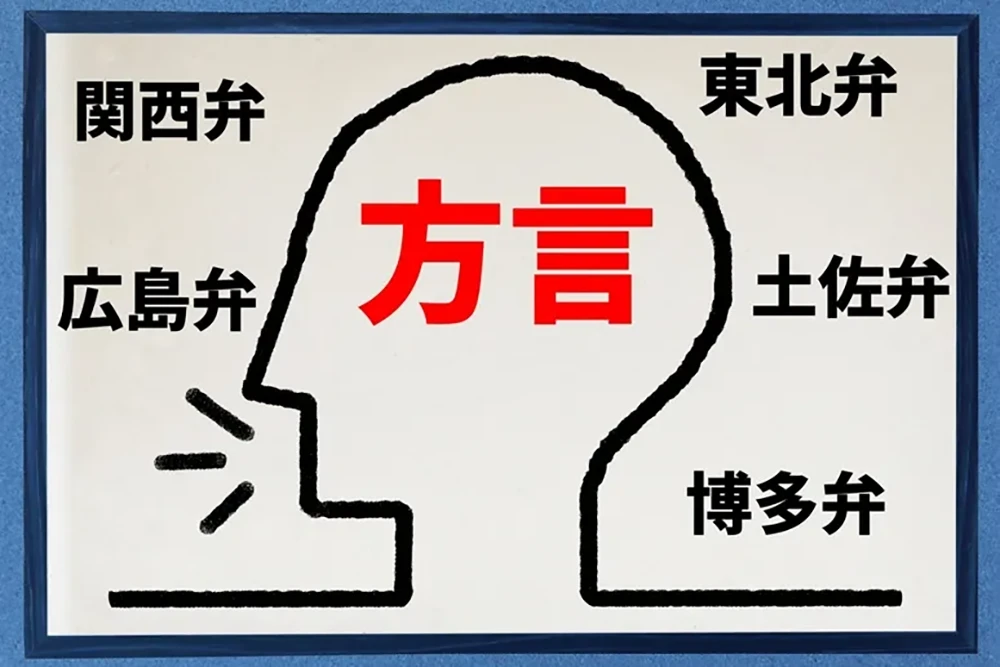
Discovering Japanese Dialects: Kansai-ben, Kanto-ben, Tsugaru-ben, and More
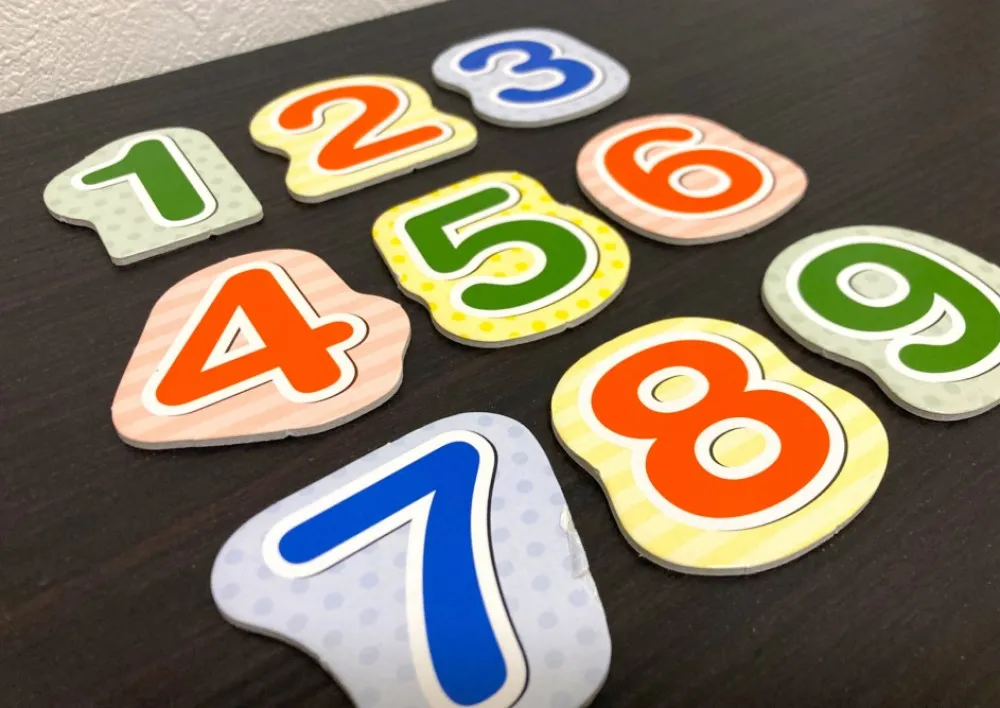
Difficult Japanese Words: Numbers And the Way to Count Them







